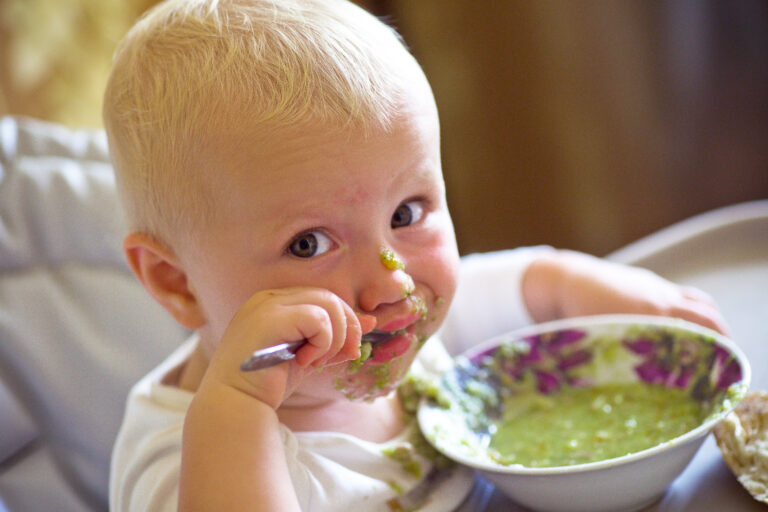Transitioning your baby to solid foods is one of those milestone moments in parenting that’s as exciting as it is daunting.
In my years of working with children between 3 months and 5 years old, I’ve been right there alongside many parents as they navigate this journey.
Through caring for children, I’ve gathered a wealth of knowledge and hands-on experience.
Today, I want to share with you 5 essential tips that I’ve found invaluable for making the transition to solid foods a smooth and joyful experience for both you and your baby.
Understanding the Signs of Readiness
In my experience, every baby is unique and will show signs of readiness for solid foods in their own time. Typically, these signs start to show around 6 months old, but I’ve seen it vary.
Looking for Physical Cues I’ve personally seen babies who were ready for solids showing a keen interest in what I was eating, reaching out for my food, and even opening their mouths if food came close. It’s been my secret weapon to tell parents to look for these cues.
Sitting Up with Support Another sign I’ve found to be reliable is when a baby can sit up with minimal support. This indicates they have the necessary control to start eating solid foods.
Loss of the Tongue-Thrust Reflex I’ve tried spoon-feeding babies who weren’t quite ready, and they’d push the food out with their tongues. This reflex naturally diminishes as they become ready for solids.
Choosing the Right Foods
When it comes to selecting the first solid foods, I’ve gathered some go-to options that are both nutritious and easy on your baby’s developing digestive system.
Start Simple From what I’ve experienced, starting with single-ingredient foods is best. Pureed vegetables, fruits, and iron-fortified cereals are excellent first foods. I’ve personally tested this technique and found it helps in identifying any food allergies or sensitivities early on.
Introduce New Foods One at a Time It’s been my strategy to recommend introducing new foods one at a time, waiting 3-5 days before adding another into the mix. This way, if there’s a reaction, it’s easier to pinpoint the cause.
Texture Matters In my journey in childcare, I’ve seen babies respond differently to textures. Starting with smoother purees and gradually moving to more textured foods as they get used to eating solids has worked well.
Making Mealtime Positive
Mealtime should be a positive, stress-free experience for your baby. In my years of working with young families, I’ve discovered some secrets to keeping it light and enjoyable.
Stay Patient and Encouraging In my experience, patience is key. Some babies take to solids right away, while others need more time. I’ve found that showing excitement and encouragement when they try new foods, even if they’re not keen at first, often leads to curiosity and willingness.
Let Them Get Messy It’s been my observation that babies learn through their senses. Allowing them to touch and play with their food can be a messy affair, but it’s a fantastic learning opportunity. I’ve personally used this approach to make mealtime fun and educational.
Eat Together Through my adventures, I’ve seen how babies mimic the people around them. Eating your meals together, showing them how you eat and enjoy food, can be a powerful motivator for them to try solids.
Listening to Your Baby
Every baby communicates in their own way, especially when it comes to hunger and fullness. Tuning into these cues is something I’ve stressed in my advice to parents.
Recognizing Hunger and Fullness Cues From what I’ve experienced, babies who are ready to eat lean in, open their mouths, and may even get excited. Conversely, when they’re full, they might turn away, lose interest, or close their mouths. It’s important to respect these signals.
Flexibility is Key In my journey in childcare, I’ve found that flexibility with feeding times and amounts is crucial. Some days your baby might be hungrier than others, and that’s perfectly normal.
Navigating Challenges
Transitioning to solid foods isn’t always a smooth road. I’ve personally tested different techniques to overcome common challenges.
Dealing with Rejection It’s been my experience that babies might initially reject new foods. I’ve tried offering the same food in different ways or mixing it with a favored food, which often leads to acceptance.
Consistency Over Time I’ve seen that consistency is key. Regularly offering a variety of foods, even those previously rejected, can eventually lead to a breakthrough.
Seeking Support When Needed I’ve always encouraged parents to seek support if they’re concerned about their baby’s eating habits. Pediatricians and childhood nutrition experts can offer valuable guidance.
Final Thoughts
Transitioning your baby to solid foods is a journey filled with discoveries, challenges, and milestones. Each baby’s path is unique, and there’s no one-size-fits-all approach.
Through my time in childcare, I’ve seen the joy and growth that comes from expanding your baby’s palate. Remember, you’re not just feeding them; you’re nurturing their curiosity, encouraging their independence, and laying the foundation for healthy eating habits that will last a lifetime.












